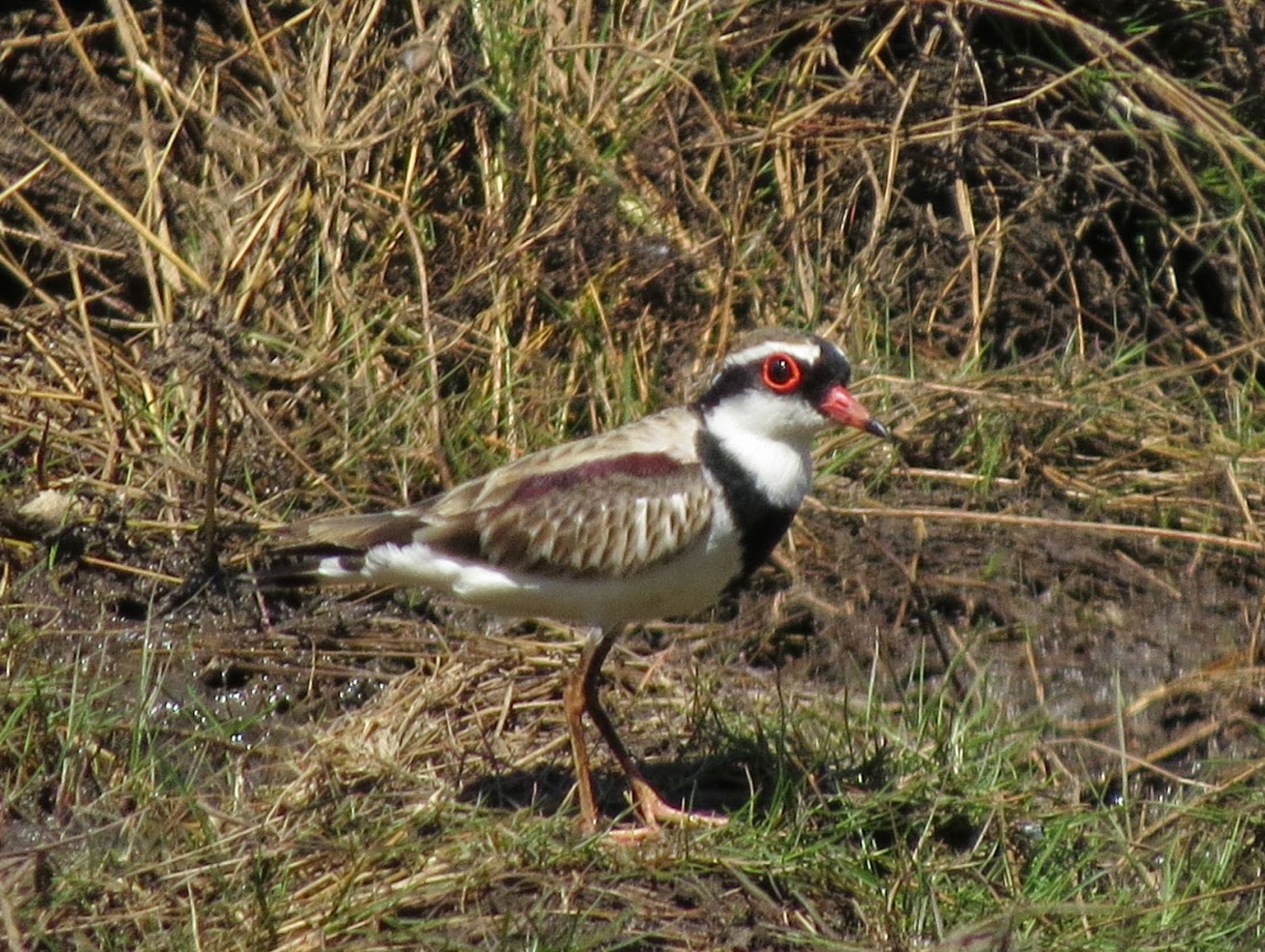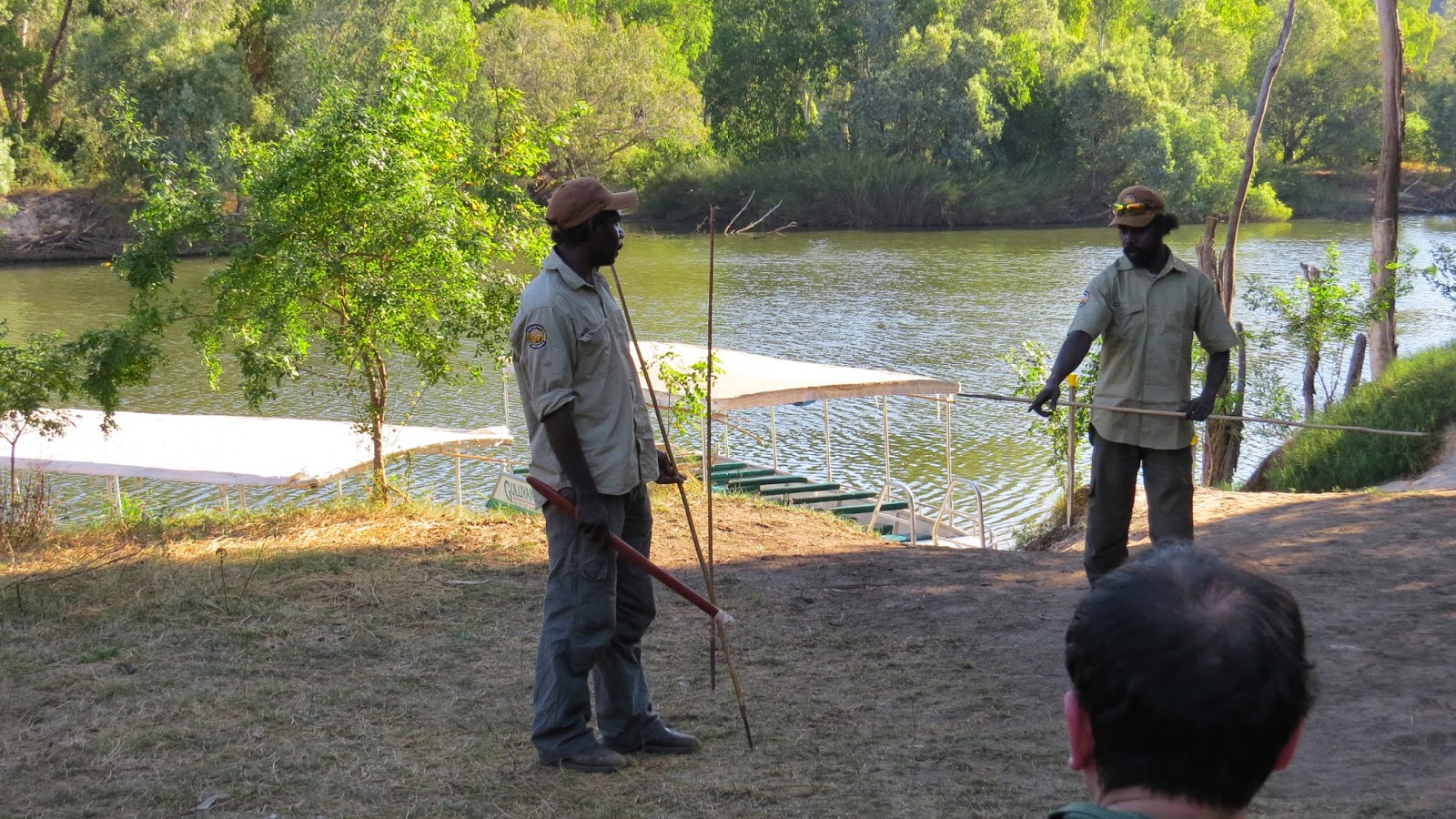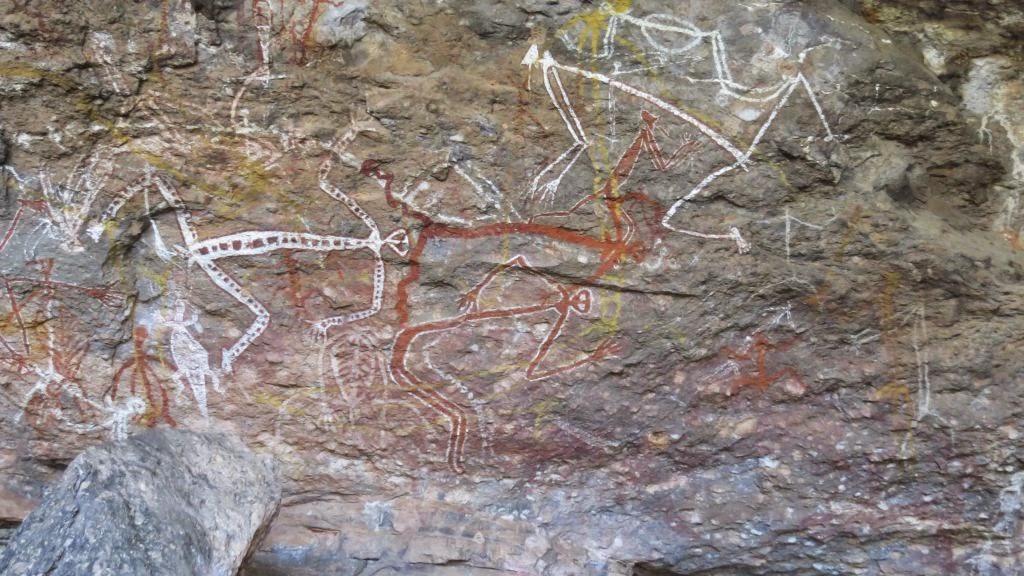Our car is an X-Trail, top of the
line model, late 2010. It has a 16" spacesaver spare (joke as
the space fits a full-sized tyre), rated for 80kph; the 'real' tyres are
18" low profile and hard to get. David was aware of problems and
tried to buy secondhand wheels in Brisbane - no luck. Also the spare is
mounted under the boot floor, so when we blew a tyre on the Savannah Way just
20k from Borroloola on a Saturday, we had to remove everything from the boot,
goods, floor, drawers.
The news was worse when we got to B
- not repairable as a stone had cut the sidewall. Phone calls to Katherine
thankfully led to Bridgestone having suitable tyres in stock on Monday.
So we spent an extra day in Borroloola, as we wanted to revisit Caranbirini on
the way to Katherine. Photos below show why Caranbirini is such a special
place.
 |
| Green pygmy-geese |
Click on the photo above to see what David found. We think this little lizard is Diporiphora albilabris sobria.
Drove another 4.5 hours and spent the night at Hiway Inn near the famous Daly Waters hotel, where we stayed in 2008. We were in the mood for a quiet night, not on offer there. Had a view over paddocks of red-winged parrots, cockatiels, galahs, rainbow lorikeets, apostle birds, grey kangaroos and more. Dined at the Inn and had a peaceful night.
Spent the next day in Katherine shopping and getting 2 new tyres fitted. David now has a spare tyre (no wheel) as well as our 80kph 'dummy' spare.
In Darwin we stayed at Big 4 Howard Springs for 4 days on a big grassy private site where we were visited by a brushtail possum and a nonchalant orange-footed scrubfowl.

Howard Springs and Berry Springs are family-friendly places in tropical forest surrounds.
At Territory Wildlife Park, an excellent bird of prey show included
a black-breasted kite using a stone to break open a dummy emu egg with meat
inside. Star of the show was
the osprey, which plunged into water vertically to get a fish which it then tore
apart and ate just above the heads of several people.
Whistling and black kites, not part of the show, tried to get into the
act and the osprey showed them who was boss. In the aquarium sawfish and
freshwater whipray were of more interest than the immobile fresh and saltwater
crocodiles.

A 3m saltie and beautiful Little Kingfisher were notable features at Fogg Dam.

Darwin Museum & Art Gallery was well worth a visit. They have a very impressive collection of Aboriginal art. We were amazed at the tiny marine creatures in a photographic exhibition.
We missed out on the champagne sunset cruise which we enjoyed in 2008. However, the much cheaper Streeter Sunset Cruise BYO was a good way to spend a lazy afternoon.

I found bird-watching sites on the web so we explored a few places including
Knuckey Lagoons, where we saw this darter and 17 other species including an
Australian pratincole.
 Drove 3 hours from Darwin to Kakadu Lodge, Jabiru. Found a shady
spot (site 1) next to the pool and near amenities. There we were visited
by a channel-billed cuckoo, blue-faced and white-gaped honeyeaters.
Drove 3 hours from Darwin to Kakadu Lodge, Jabiru. Found a shady
spot (site 1) next to the pool and near amenities. There we were visited
by a channel-billed cuckoo, blue-faced and white-gaped honeyeaters.
 |
|
| Short-eared rock wallaby at Ubirr |
The next day was crammed with action - Ubirr in the morning, Arnhem Land trip up the river in the afternoon.
Our Ubirr guide told us stories behind each painting featuring human figures and pointed out the fact that the main gallery is to a large extent a menu, showing food available.
 |
| Thylacine, Main Gallery |
 |
| Beheaded mullet |
 |
| Lookout Ubirr |
Paintings obvious in the Gallery were done in 1962-65
when elders from outside Kakadu who knew about ceremony here decided to
preserve the heritage. By the time
Kakadu became a national park in 1979, buffalo had already rubbed off older
paintings, ridding themselves of spinifex.
Leichhardt was here in 1845 and made welcome by the
Aborigines, some of whom could speak English.
Archaeologists in recent years dug 1.5m down at Anbangbang Shelter under the watchful
eyes of elders, who were helpful in explaining the uses of artefacts
found. Annie showed us a grinding stone
and a ‘horses hoof’ core tool (used to make spear heads) which were at least
20,000 years old and would have been left here for others to use as they are
too heavy to tote. Spear heads of quartz
and ironstone were also found. Small
velvety ‘stems’ with burnt heads were recognized by the elders as banksias
‘matches’, carried by women.
David felt very ill during this talk. We decided to
leave, foregoing the steep climb to the lookout.
Instead, we drove to nearby Anbangbang Billabong,
shared a banana and did the 2.8km flat, mostly shady walk around the
billabong. I saw 18 birds in an hour,
including a big flock of plumed whistling duck, magpie geese, a pair of
black-fronted dotterels, corellas, white and black cockatoos, Pacific heron and
a female rufous whistler.
 |
| Black-fronted dotterel |
 |
| Little corellas |
 |
| Plumed whistling ducks |
David drove 50km on to Mardugal near Cooinda to check
out campsite (good camp) but I drove back to Jabiru as he felt too sick and
drowsy. We had a short swim after a late
lunch, then David spent ages trying to find why our 12V system does not seem to
be charging.
After dinner we listened
to the ranger talk, Buffalo Days, and had the chance to taste Buffalo
Carpaccio. Interesting talk on early
days. In 1820 ? the British set up an army
camp at Port Essington, bringing in buffalo, pigs, deer and cattle from
Indonesia. All animals were left behind
when the place was abandoned and they survived.
Game hunters flew into Kakadu before roads were built. Later, from 1900 to WW2, buffalo were shot
for leather used in machinery belts, etc. Aboriginal women skinned and salted the hides. These days, buffalo are a menace and 300,000
were culled over some years after Kakadu was declared a NP. They still have to kill several thousand a
year.
Went to Mamukala wetlands, back on the road to
Darwin, seeing 20 bird species from a sumptuous bird hide and along the 3 km
walking track. Four finch species –masked,
crimson, long-tailed and double barred - were feeding together on a burnt piece
of ground in pandanus territory.
 |
| Masked finch |
|
|
|
|
|
 |
| Female crimson finch |
 |
| Jacana, perhaps male, and chick |
At Jabiru in the evening Annie gave a talk on the work
done by rangers and local people to keep tourists safe (move crocs), natural
environment healthy (remove pest species- big mimosa program), infrastructure
intact (repairs after wet season; remove walkways before wet season; clear boat
ramps of mud). Well presented and most
informative.
Investigated 2 other billabong camps before arriving at Mardugal, where we rested until driving to Coinda for our 3:30 Yellow Waters cruise.
 |
| Overnight camp at Mardugal | | | |
|
The sunset cruise started at 4:30 when birds are particularly active.
 |
| This Pacific heron has a defiant pose, having dined on the back of a crocodile, which thrashed around to show his annoyance. |
 |
| Great egret |
 |
| Jabiru on flood plain |
 |
| One of the few crocs sighted |
 |
| Whistling kite |
 |
| Wandering whistling ducks |
 |
| Lotus flower |
 |
| 6:37pm |
 |
| 7:00pm |
 |
| 7:05pm |
David and his Canon camera, 50 zoom, did well to capture these images, especially of the jabirus, each at around 500m and the nest in fading light.
Next morning I was delighted to see a Little Shrike-thrush and 2 m
and 2 f Shining Flycatchers on the Mardugal Billabong walk, though the water
was far too deep for waders. Easy drive to Katherine where we stayed at Low Level Caravan Park and booked the 9am 3 Gorge 4 hour cruise. Our guide was not local and had only been
there 2 months. However, he was a
competent boat handler and we were lucky that just 8 people were on this cruise
(vs booked out on all other cruises).
 |
| First gorge |
 |
| Second gorge |
 |
| Red Lily Pond |
Interesting
info he imparted:
Campbell was a pioneer who never knew about the gorge
but named Edith Falls and Flora River after his daughters.
Freshwater crocodiles eat what they can swallow whole, so humans
are safe. Used to be 5000 but reduced to
1000 because of cane toads.
Dunlop Swamp, 50m deep, is the reason for a very green
section, with native lasiandras, silver-leafed paperbarks, supplejacks, ferns.
Deepest point in all the 13 gorges is in the second
gorge, 40-50m deep.
Rocks are 2 billion year old layers of sandstone and
conglomerates – too old for fossils.
There are more than 380 rock art sites in Nitmiluk. Rock art in the second gorge is 8000-10,000 yrs old. It was hard to get interesting photos because of position or faintness of pigment.
Elsey National Park near Mataranka is a lovely place but the weather was very hot while we were there for 3 days. We revisited several places which were great in 2008, did the Botanic Walk at 9am and had a swim at 4 Mile.
 |
| shady Botanic Walk |
 |
| At least he didn't have the car keys in his pocket, just a hanky! |
After lunch back at camp, we drove to nearby Bitter Springs for refreshing if rather warm swim. The water runs so fast that some people (not us) used aids and everyone walks back to the start.
 |
| Bitter Springs |
We put our kayak in at 12 Mile and turned back after a while as there was
nothing special to see and it was so hot. I alighted at
the swimming pontoons and walked back to the car while David enjoyed a short
solitary paddle.
 |
| Stevie's Hole, a favourite for fisherfolk |
Returned to the Botanic
Walk the next day and took the path to Stevie’s Hole. Walked 5.2km from 9am in mostly shady conditions. Very pretty, through paperbark swamps and
bauhinia woodland. Stevie’s Hole had a sandy bottom but was
strangely murky, odd as other water places were exceptionally clear. Home for lunch – hot!
 |
| Roper River, Elsey NP - too shallow here for a swim with freshwater crocs |
|
|
|
Now heading for WA, stopping for food at Katherine supermarket. Frustrating – 30 minute queues for checkout; several items not available
because of a train derailment 3 days ago.
Saw beer being transferred from one road train to another at Mataranka,
probably for the same reason.
Our last night in NT was spent at Keep River National Park, a mini version of the Bungles. Checked out the birds at Cockatoo Lagoon, mostly magpie geese. Walked the 8km loop in 2 ½ hours, seeing view from
lookout and art site before sunset.
 |
Boab Adansonia gregorii
|
 |
Carpentaria palms
|
 |
Kapok trees Cochlospermum fraseri
|
We left the Northern Territory on 4 August, driving just 30km to Kununurra in Western Australia.




 Drove 3 hours from Darwin to Kakadu Lodge, Jabiru. Found a shady
spot (site 1) next to the pool and near amenities. There we were visited
by a channel-billed cuckoo, blue-faced and white-gaped honeyeaters.
Drove 3 hours from Darwin to Kakadu Lodge, Jabiru. Found a shady
spot (site 1) next to the pool and near amenities. There we were visited
by a channel-billed cuckoo, blue-faced and white-gaped honeyeaters.



























































No comments:
Post a Comment